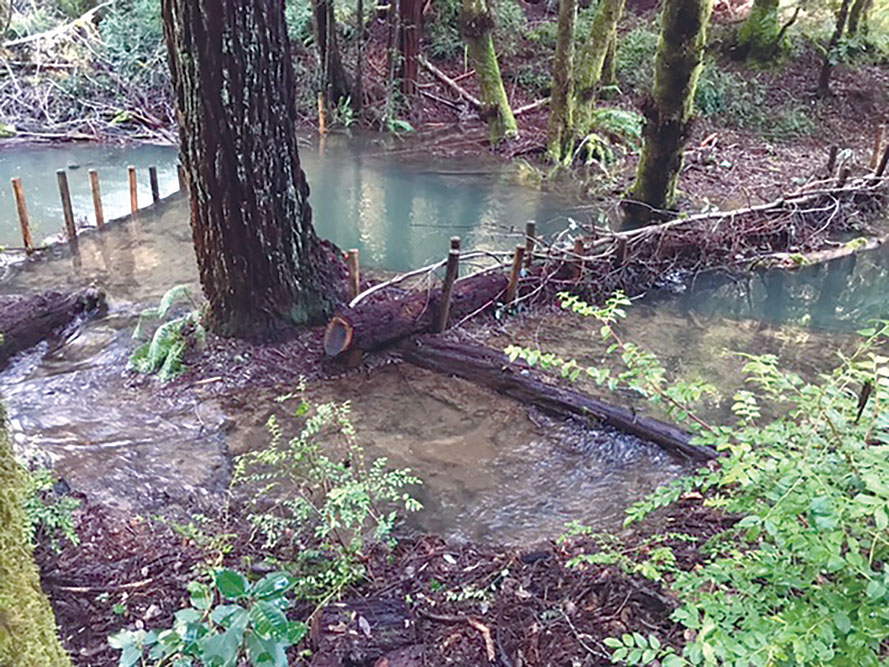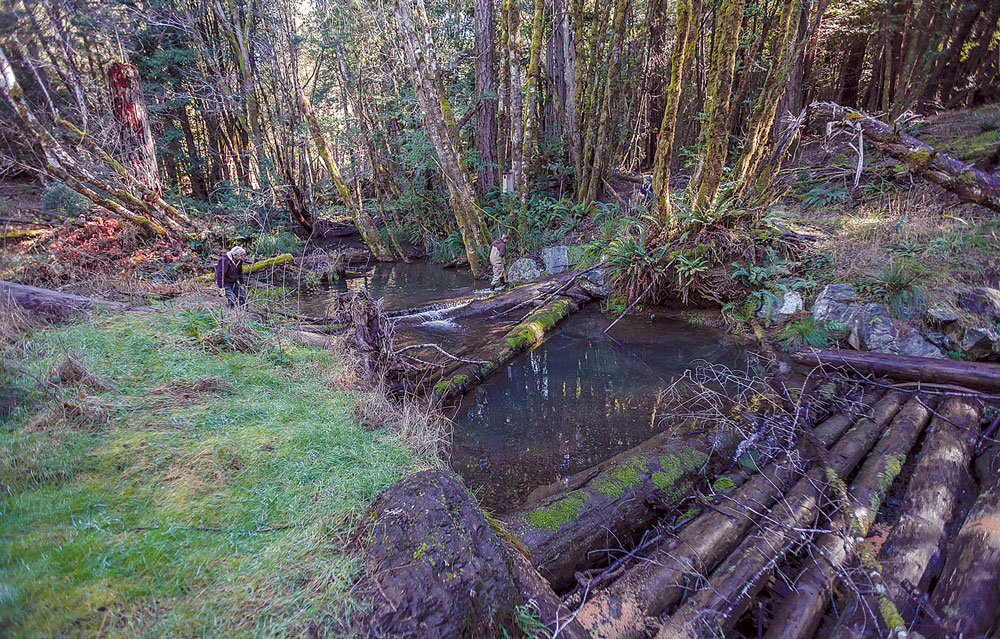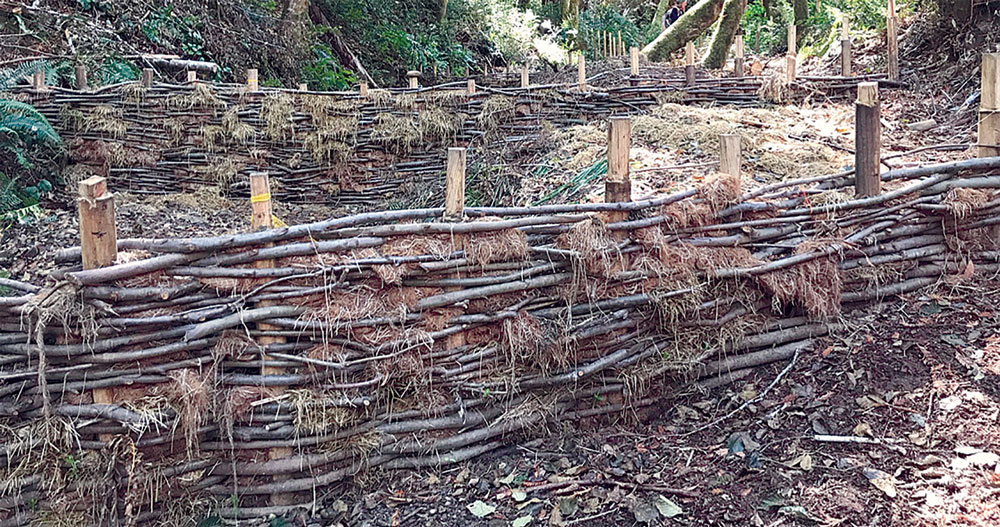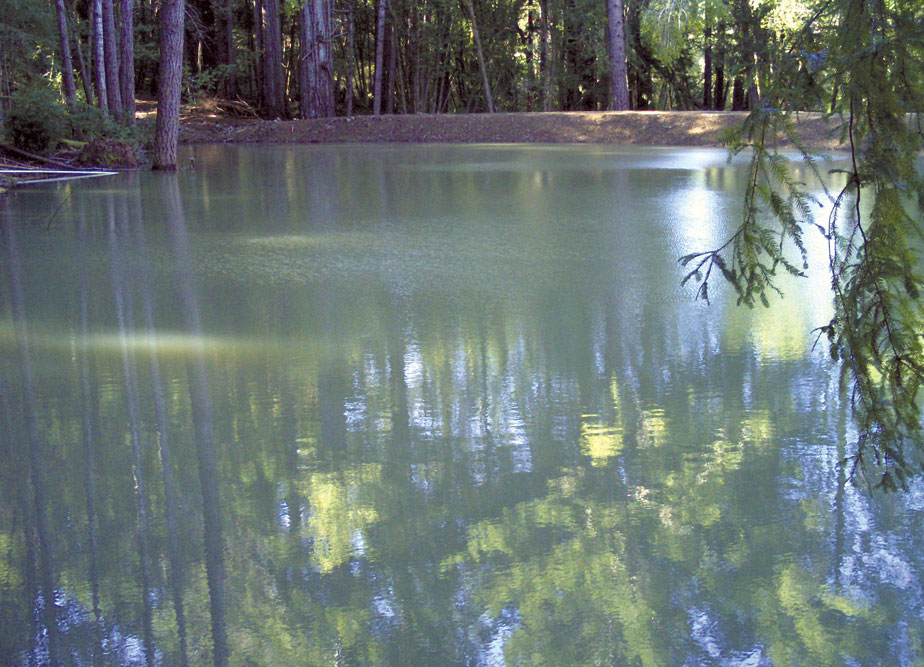Collaborative Partnerships Key to Restoring the Mattole River Watershed

Sanctuary Forest, Mattole Restoration Council, and Mattole Salmon Group
By April Newlander, Sanctuary Forest
The Mattole River watershed, located in southern Humboldt and northern Mendocino counties, is a unique landscape of coastal mountain ranges, forests, prairies, and creeks. The Mattole is home to several threatened and endangered species and species of concern, including the coho salmon, Chinook salmon, steelhead trout, marbled murrelet, northern spotted owl, torrent salamander, tailed frog, pine marten, and others. Salmon have been of major community interest since their decline was noted in the late 1970s. A significant amount of community collaboration has occurred in the interest of restoring this culturally and economically important resource. Native salmon recovery is a priority of restoration work in the Mattole River watershed, beginning with the pioneering work of the Mattole Salmon Group (MSG) in the late 1970s and early 1980s, which focused on in-stream and direct fisheries enhancements. Restoration efforts were broadened when the Mattole Restoration Council (MRC) was formed in 1982 and began to address upslope restoration, the relationships between vegetation patterns and salmonids, and later the role of fire in the watershed. Sanctuary Forest (SFI), a land trust in the headwaters of the Mattole watershed, was formed in 1987, with a focus on conserving the watershed through conservation easements and land acquisition.
For more than 30 years, restoration efforts in the watershed have been conducted through partnerships with residents and landowners, industrial timberland owners, state and federal agencies, community organizations, volunteer groups, scientists, and other land management agencies. Starting in 2002, MRC, MSG, and SFI entered into subcontracting arrangements to complete various restoration and watershed planning projects under the umbrella of the Mattole River and Range Partnership (MRRP). Sponsored by the Bella Vista Foundation and the Resources Legacy Fund Foundation, the partnership was formalized in 2008 with a Memorandum of Understanding (MOU) that defined key roles for each organization. The MOU is essentially a detailed decision matrix of core program areas and functions, where each group is assigned a lead role in various niche areas (land conservation, restoration, streamflow, education, etc.). A flow chart for decision-making facilitates agreements. When there’s an opportunity to develop a new project or seek funds, the MOU explicitly directs the lead group to decide whether it has the capacity to take it on, or wants to offer or assign it to another group member. This process is supported by monthly meetings of the executive directors of the three organizations.
[EDITOR’S NOTE: In the print version of this story in the Forest & River News Summer 2020 issue, the caption on the photo below of Baker Creek was erroneously switched with the caption for the photo of Lost River (above). The captions are corrected here, and we regret the error.]

The desire to reduce funding competition and the opportunity for joint grant-seeking were the main factors driving the three groups to formalize the partnership. Joint grant-seeking benefits all parties, as it lessens the administrative time spent managing three different contracts for both the grantee and grantor, and the grantor does not have to choose among three proposals in the same watershed. Bella Vista Foundation has been funding the MRRP since 2008 for critical work such as salmonid population and streamflow monitoring, planning, and permitting for groundwater recharge projects, fuels reduction work for fire safety and forest health, developing land conservation projects, and much more. The MRRP also receives joint funding from the Conservation Lands Foundation (CLF), through the King Range Alliance, which is comprised of the MRRP and Friends of the Lost Coast (formerly Lost Coast Interpretive Association). CLF funds restoration work and education projects on BLM public lands and in the surrounding King Range National Conservation Area.
There are times when submission of joint grant proposals does not make sense. One project may be a better fit for a certain funder, or a project may be more developed and have a higher likelihood of getting funded, but MRRP partners still work together to reduce competition between groups. For example, if there is more than one round of funding available in the same year, the groups may stagger proposals. Occasionally all groups submit separate unique proposals to the same round of funding, as there is no way to know which project will receive funding; and even when some proposals succeed and others don’t, it benefits us all when a partner group is funded to implement projects in the watershed. Ultimately, the MOU makes a stronger, more efficient, collaborative partnership that expands funding opportunities for the entire watershed.

Photo courtesy of SFI
Commonly, MRRP partners work together by subcontracting to each other under a grant agreement. Since there are a lot of overlapping interests among the groups, other factors may come into play when deciding who will take the lead role in a project. With SFI in the headwaters and MSG and MRC over two hours away at the mouth of the Mattole, the geographical location of the project or an existing relationship with a landowner might dictate who will be the lead organization. There are two pilot projects in the headwaters of the Mattole that highlight this type of arrangement, where SFI is the lead organization and MSG and MRC are subcontractors.
The Baker Creek Coho Recovery Project was developed in response to extremely low flows and lack of rearing habitat in Baker Creek, a historically productive creek for coho salmon. In 2012, the first instream structures were installed, which resulted in an immediate improvement of
habitat for coho salmon. While there was a significant improvement in early to mid-summer flows, late summer flow was still insufficient. This led to the development of a terrace groundwater recharge project in 2016, aimed at increasing groundwater storage upslope of the instream habitat restoration project. This will ideally result in streamflow benefits sufficient to maintain pool habitat in Baker Creek even in the most severe drought years. This was accomplished through the construction of earthen berms that form infiltration ponds within the natural topography of the landscape. The design is based on the concepts of slowing down run-off and increasing infiltration such that the groundwater levels are higher in the spring and decline more slowly through the summer. Additional objectives include restoration of the wetland ecosystem and expanding the patches of wetland vegetation by raising the adjacent groundwater level. As the wetland expands, so does the organic content of the soil, which will then improve the water holding capacity and decrease the rate of groundwater decline, with increased habitat benefits for fish and wildlife.
SFI is the lead organization for streamflow enhancement and water conservation, per the MRRP MOU chart of interests, and thus it is the organization that applies for the funding, with MSG and MRC supporting as subcontractors. MSG is the lead for instream fish habitat enhancement and salmonid monitoring, and its members have installed several log and boulder weirs over the years. They will continue to work on stream improvement projects and monitor juvenile salmonid populations to assess their recovery in Baker Creek. MRC is the lead MRRP group for vegetative restoration and will assist with the restoration of the wetland ecosystem. They are providing native grasses, wildflowers, sedges, shrubs, and trees, sourced from their native plant nursery in Petrolia. They will also be preparing the planting plan, and training volunteers to assist with planting, in fall 2020.

Photo courtesy of SFI
Upriver from Baker Creek is Lost River, just miles from the top end of the Mattole River. Lost River has been a priority tributary for SFI since the early 2000s because of its high potential for salmon spawning and rearing if the habitat could be restored. After years of planning efforts, the first post-supported beaver dam analog (BDA) project in the Mattole was implemented in 2019. Intended to improve salmonid habitat, increase groundwater storage, reconnect floodplains, and restore the adjacent wetland habitat, over twenty BDA structures were installed. Among the numerous partners that made this project possible, MRRP partners were vital to its success. MSG assisted with the installation of the structures, together with the California Conservation Corps, SFI staff, and volunteers. The structures consisted of pine posts with willow branches hand-woven between the posts, then packed with streambed material, clay, and straw. MRC harvested the willow from the river bar on Lighthouse Road in Petrolia, then delivered it to the job site in bundles. This was no easy feat—the bundles weighed hundreds of pounds and had to be kept wet to be able to be woven between the posts, so you can imagine the labor and attention this required. Ultimately, this was a very labor-intensive project, but the dedication shown by volunteers was truly a labor of love. We are happy to report that winter rains were held in the streambed and water spread across the floodplain. Whether this results in sustained stream flows throughout the summer—well, we will have to wait and see.
These are just a couple of examples of projects MRRP partners work on together. Restoration and collaboration continue downriver as MSG and MRC lead projects that are restoring historic meadows, improving fish habitat using wood from fuel-break projects or donated from private landowners, and carrying out other slough channel and riparian restoration projects. All these projects demonstrate the spirit of collaboration that is strong in the Mattole—bringing together people with diverse perspectives, from this watershed and others, to share knowledge and sustain a healthy and vibrant environment for all life.
The MRRP thanks all who have helped along the way—there are too many to name. Thanks also to the Cereus Fund of Trees Foundation, as they recognize the necessity of working together and continue to fund the MRRP groups’ goal of achieving the greatest good for the entire watershed.
For more information:
www.sanctuaryforest.org, www.mattole.org, www.mattolesalmon.org
